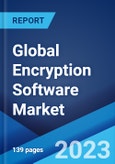The global encryption software market size reached US$ 12.1 Billion in 2022. Looking forward, the market is expected to reach US$ 28.6 Billion by 2028, exhibiting a growth rate (CAGR) of 15.42% during 2022-2028.
Encryption software is a program that relies on data encryption algorithms to protect sensitive data at rest or in transit. It allows the encryption of the content of a data object, file, network, or application, and laptops, tablets, and removable media. It assists in providing complete data protection, maintaining integrity, and ensuring security across multiple devices and safe transportation of data. As it also aids in streamlining the operations of an organization’s applications and workflows, its demand is escalating around the world.
Encryption software is a program that relies on data encryption algorithms to protect sensitive data at rest or in transit. It allows the encryption of the content of a data object, file, network, or application, and laptops, tablets, and removable media. It assists in providing complete data protection, maintaining integrity, and ensuring security across multiple devices and safe transportation of data. As it also aids in streamlining the operations of an organization’s applications and workflows, its demand is escalating around the world.
Encryption Software Market Trends
Due to the growing trend of the Internet of Things (IoT) and Bring Your Own Device (BYOD) among enterprises, there is a significant rise in data security concerns, such as cyberattacks, data breaches, commercial espionage, and theft and losses. This represents one of the key factors catalyzing the demand for encryption software to protect sensitive data and ensure compliance worldwide. Apart from this, as enterprises are increasingly adopting cloud computing, there is a considerable need for safeguarding data. This, in confluence with the growing penetration of high-speed internet and surging sales of smartphones across the globe, is positively influencing the market. Furthermore, several industry verticals, including the banking, financial services, and insurance (BFSI) and the healthcare sectors, are complying with payment card industry data security standard (PCI DSS) and the health insurance portability and accountability act (HIPPA). These regulations require the implementation of a data security solution, which is acting as another growth-inducing factor. Other major factors, including the expanding information and technology (IT) and telecom sector and advancements in mobile technology worldwide, are anticipated to drive the market further in the upcoming years.Key Market Segmentation
This research provides an analysis of the key trends in each sub-segment of the global encryption software market report, along with forecasts at the global, regional and country level from 2023-2028. The report has categorized the market based on component, deployment model, organization size, function and industry vertical.Breakup by Component:
- Software
- Services
Breakup by Deployment Model:
- On-premises
- Cloud-based
Breakup by Organization Size:
- Large Enterprises
- Small and Medium Enterprises
Breakup by Function:
- Disk Encryption
- Communication Encryption
- File and Folder Encryption
- Cloud Encryption
Breakup by Industry Vertical:
- BFSI
- Aerospace and Defence
- IT and Telecom
- Media and Entertainment
- Government and Public
- Retail
- Healthcare
Breakup by Region:
- North America
- United States
- Canada
- Asia-Pacific
- China
- Japan
- India
- South Korea
- Australia
- Indonesia
- Europe
- Germany
- France
- United Kingdom
- Italy
- Spain
- Russia
- Latin America
- Brazil
- Mexico
- Middle East and Africa
Competitive Landscape
The competitive landscape of the industry has also been examined along with the profiles of the key players being Amazon Web Services Inc. (Amazon.com Inc), Check Point Software Technologies Ltd., Cisco System Inc., Fortinet Inc., F-Secure, International Business Machines Corporation, Microsoft Corporation, Oracle Corporation, Palo Alto Networks Inc. and Trend Micro Incorporated.Key Questions Answered in This Report:
- How has the global encryption software market performed so far and how will it perform in the coming years?
- What has been the impact of COVID-19 on the global encryption software market?
- What are the key regional markets?
- What is the breakup of the market based on the component?
- What is the breakup of the market based on the deployment model?
- What is the breakup of the market based on the organization size?
- What is the breakup of the market based on the function?
- What is the breakup of the market based on the industry vertical?
- What are the various stages in the value chain of the industry?
- What are the key driving factors and challenges in the industry?
- What is the structure of the global encryption software market and who are the key players?
- What is the degree of competition in the industry?
Table of Contents
1 Preface3 Executive Summary13 Value Chain Analysis15 Price Analysis
2 Scope and Methodology
4 Introduction
5 Global Encryption Software Market
6 Market Breakup by Component
7 Market Breakup by Deployment Model
8 Market Breakup by Organization Size
9 Market Breakup by Function
10 Market Breakup by Industry Vertical
11 Market Breakup by Region
12 SWOT Analysis
14 Porters Five Forces Analysis
16 Competitive Landscape
Companies Mentioned
- Amazon Web Services Inc. (Amazon.com Inc)
- Check Point Software Technologies Ltd.
- Cisco System Inc.
- Fortinet Inc.
- F-Secure
- International Business Machines Corporation
- Microsoft Corporation
- Oracle Corporation
- Palo Alto Networks Inc.
- Trend Micro Incorporated
Methodology

LOADING...
Table Information
| Report Attribute | Details |
|---|---|
| No. of Pages | 139 |
| Published | November 2023 |
| Forecast Period | 2022 - 2028 |
| Estimated Market Value ( USD | $ 12.1 Billion |
| Forecasted Market Value ( USD | $ 28.6 Billion |
| Compound Annual Growth Rate | 15.4% |
| Regions Covered | Global |
| No. of Companies Mentioned | 10 |









